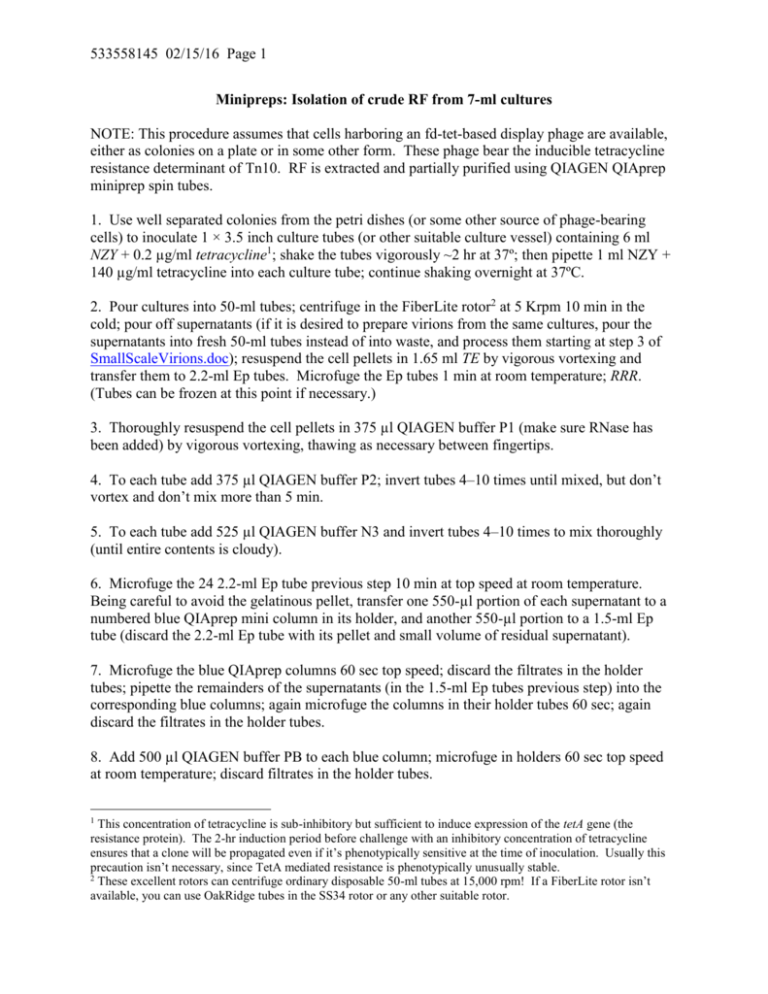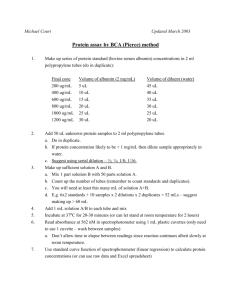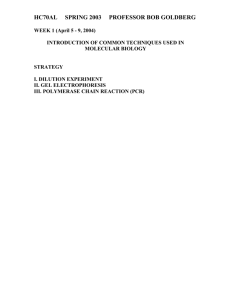RFminiprep2
advertisement

533558145 02/15/16 Page 1 Minipreps: Isolation of crude RF from 7-ml cultures NOTE: This procedure assumes that cells harboring an fd-tet-based display phage are available, either as colonies on a plate or in some other form. These phage bear the inducible tetracycline resistance determinant of Tn10. RF is extracted and partially purified using QIAGEN QIAprep miniprep spin tubes. 1. Use well separated colonies from the petri dishes (or some other source of phage-bearing cells) to inoculate 1 × 3.5 inch culture tubes (or other suitable culture vessel) containing 6 ml NZY + 0.2 µg/ml tetracycline1; shake the tubes vigorously ~2 hr at 37º; then pipette 1 ml NZY + 140 µg/ml tetracycline into each culture tube; continue shaking overnight at 37ºC. 2. Pour cultures into 50-ml tubes; centrifuge in the FiberLite rotor2 at 5 Krpm 10 min in the cold; pour off supernatants (if it is desired to prepare virions from the same cultures, pour the supernatants into fresh 50-ml tubes instead of into waste, and process them starting at step 3 of SmallScaleVirions.doc); resuspend the cell pellets in 1.65 ml TE by vigorous vortexing and transfer them to 2.2-ml Ep tubes. Microfuge the Ep tubes 1 min at room temperature; RRR. (Tubes can be frozen at this point if necessary.) 3. Thoroughly resuspend the cell pellets in 375 µl QIAGEN buffer P1 (make sure RNase has been added) by vigorous vortexing, thawing as necessary between fingertips. 4. To each tube add 375 µl QIAGEN buffer P2; invert tubes 4–10 times until mixed, but don’t vortex and don’t mix more than 5 min. 5. To each tube add 525 µl QIAGEN buffer N3 and invert tubes 4–10 times to mix thoroughly (until entire contents is cloudy). 6. Microfuge the 24 2.2-ml Ep tube previous step 10 min at top speed at room temperature. Being careful to avoid the gelatinous pellet, transfer one 550-µl portion of each supernatant to a numbered blue QIAprep mini column in its holder, and another 550-µl portion to a 1.5-ml Ep tube (discard the 2.2-ml Ep tube with its pellet and small volume of residual supernatant). 7. Microfuge the blue QIAprep columns 60 sec top speed; discard the filtrates in the holder tubes; pipette the remainders of the supernatants (in the 1.5-ml Ep tubes previous step) into the corresponding blue columns; again microfuge the columns in their holder tubes 60 sec; again discard the filtrates in the holder tubes. 8. Add 500 µl QIAGEN buffer PB to each blue column; microfuge in holders 60 sec top speed at room temperature; discard filtrates in the holder tubes. 1 This concentration of tetracycline is sub-inhibitory but sufficient to induce expression of the tetA gene (the resistance protein). The 2-hr induction period before challenge with an inhibitory concentration of tetracycline ensures that a clone will be propagated even if it’s phenotypically sensitive at the time of inoculation. Usually this precaution isn’t necessary, since TetA mediated resistance is phenotypically unusually stable. 2 These excellent rotors can centrifuge ordinary disposable 50-ml tubes at 15,000 rpm! If a FiberLite rotor isn’t available, you can use OakRidge tubes in the SS34 rotor or any other suitable rotor. 533558145 02/15/16 Page 2 9. Add 750 µl QIAGEN buffer PE to each blue column; microfuge in holders 60 sec top speed at room temperature; discard filtrates in the holder tubes; re-microfuge 60 sec to remove residual PE. 10. Put each blue QIAprep column into a labeled 1.5-ml Ep tube; carefully pipette 100 µl QIAGEN buffer EB (10 mM Tris.HCl pH 8.5) into the center of each column; allow to stand for 1 min; microfuge at top speed for 60 sec; discard columns; store 1.5-ml Ep tubes in the refrigerator or deepfreeze. The RF concentration is typically ~10–20 µg/ml; the preparation contains a great deal of other nucleic acids and other contaminants, but is OK for sequencing, restriction digestion, transfection by electroporation, and many other downstream procedures. NOTE: Use 10 µl of a miniprep for sequencing with dye terminators by standard techniques.






